At close quarters
March 1991
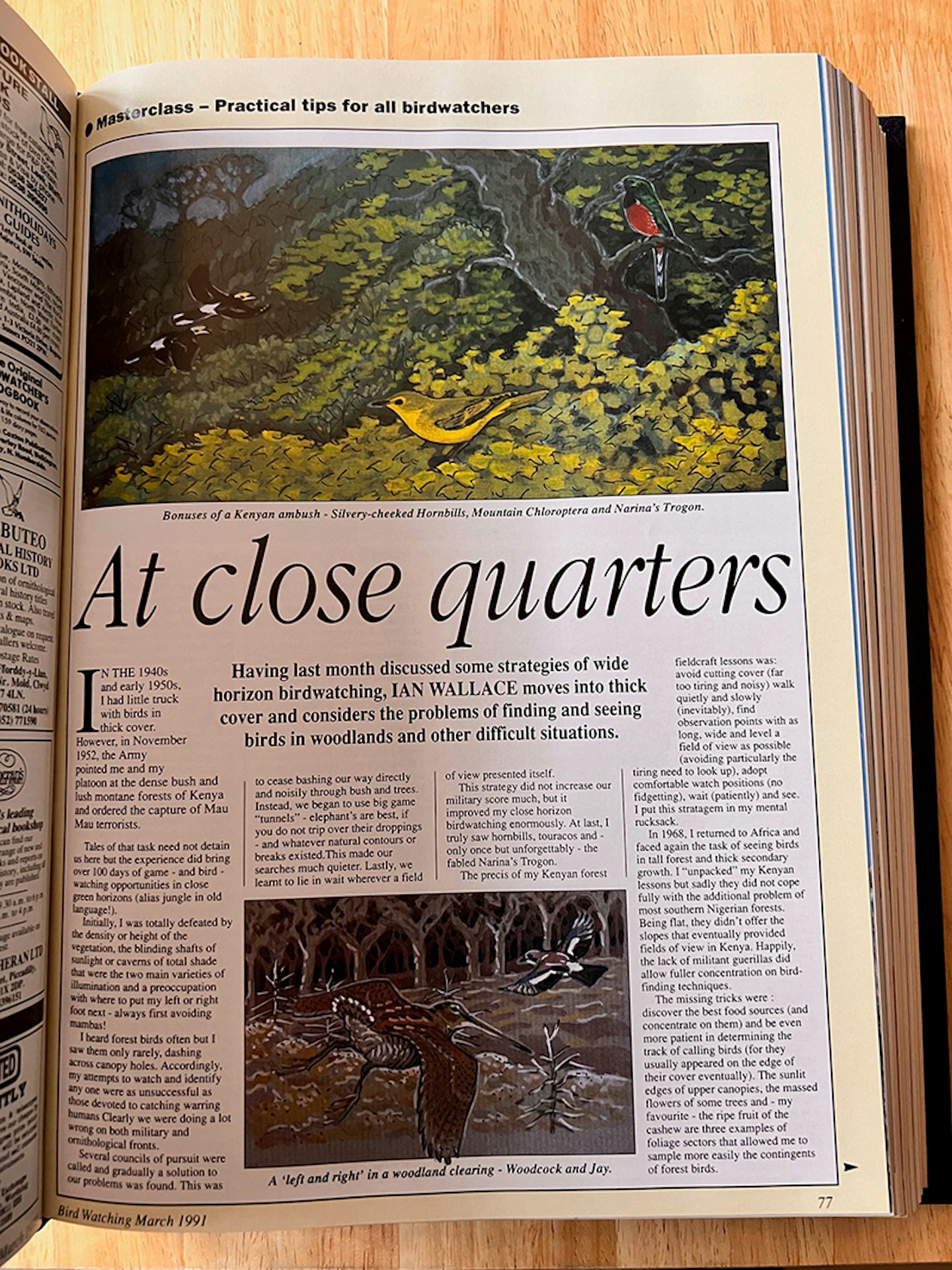
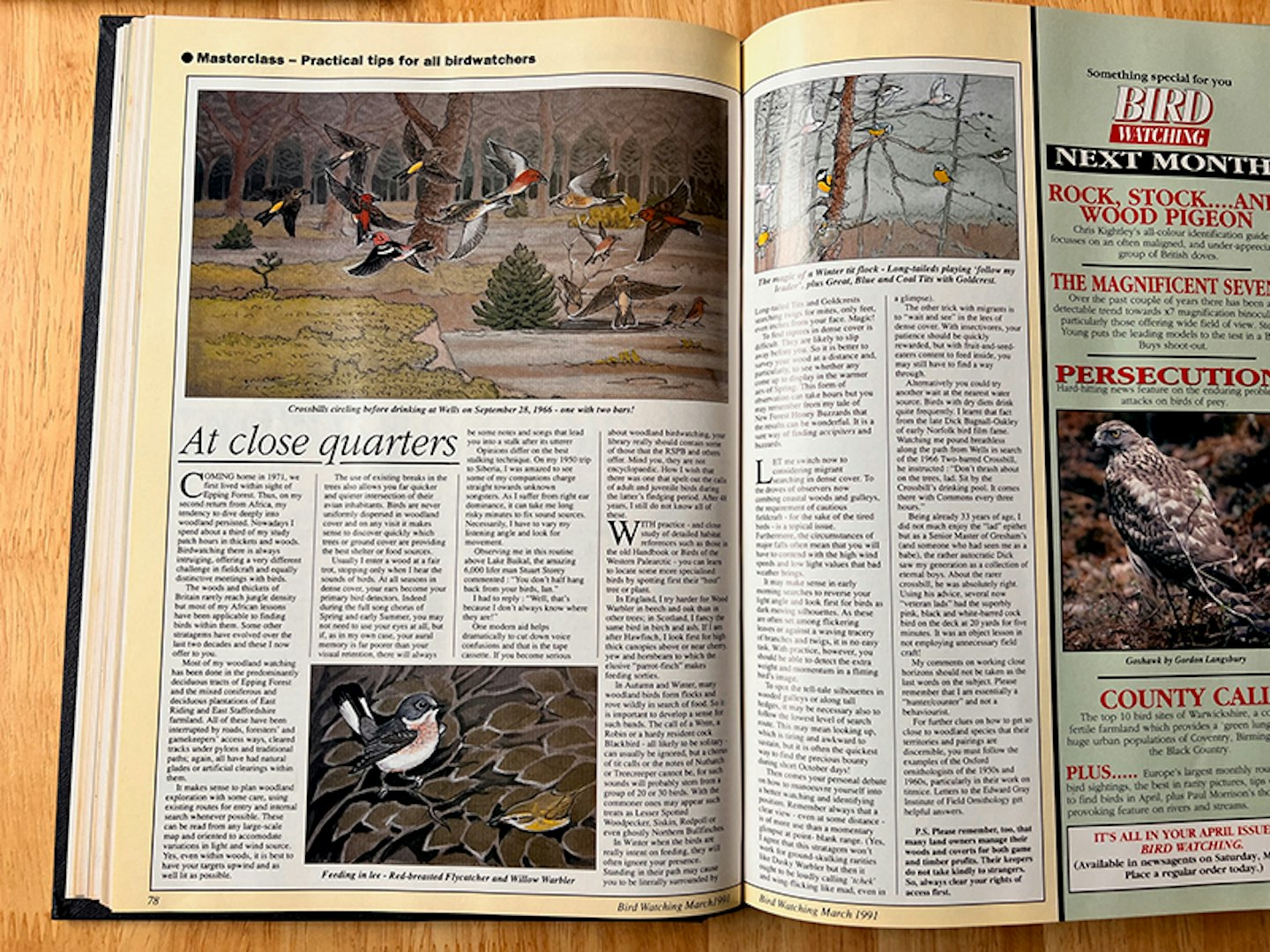
Having last month discussed some strategies of wide horizon birdwatching, Ian Wallace moves into thick cover and considers the problems of finding and seeing birds in woodlands and other difficult situations.
In the 1940s and early 1950s, I had little truck with birds in thick cover. However, in November 1952, the Army pointed me and my platoon at the dense bush and lush montane forests of Kenya and ordered the capture of Mau Mau terrorists.
Tales of that task need not detain us here but the experience did bring more than 100 days of game-watching and birdwatching opportunities in close green horizons (alias jungle in old language!).
Initially, I was totally defeated by the density or height of the vegetation, the blinding shafts of sunlight or caverns of total shade that were the two main varieties of illumination and a preoccupation with where to put my left or right foot next – always first avoiding mambas!
I heard forest birds often but I saw them only rarely, dashing across canopy holes. Accordingly, my attempts to watch and identify any one were as unsuccessful as those devoted to catching warring humans Clearly, we were doing a lot wrong on both military and ornithological fronts.
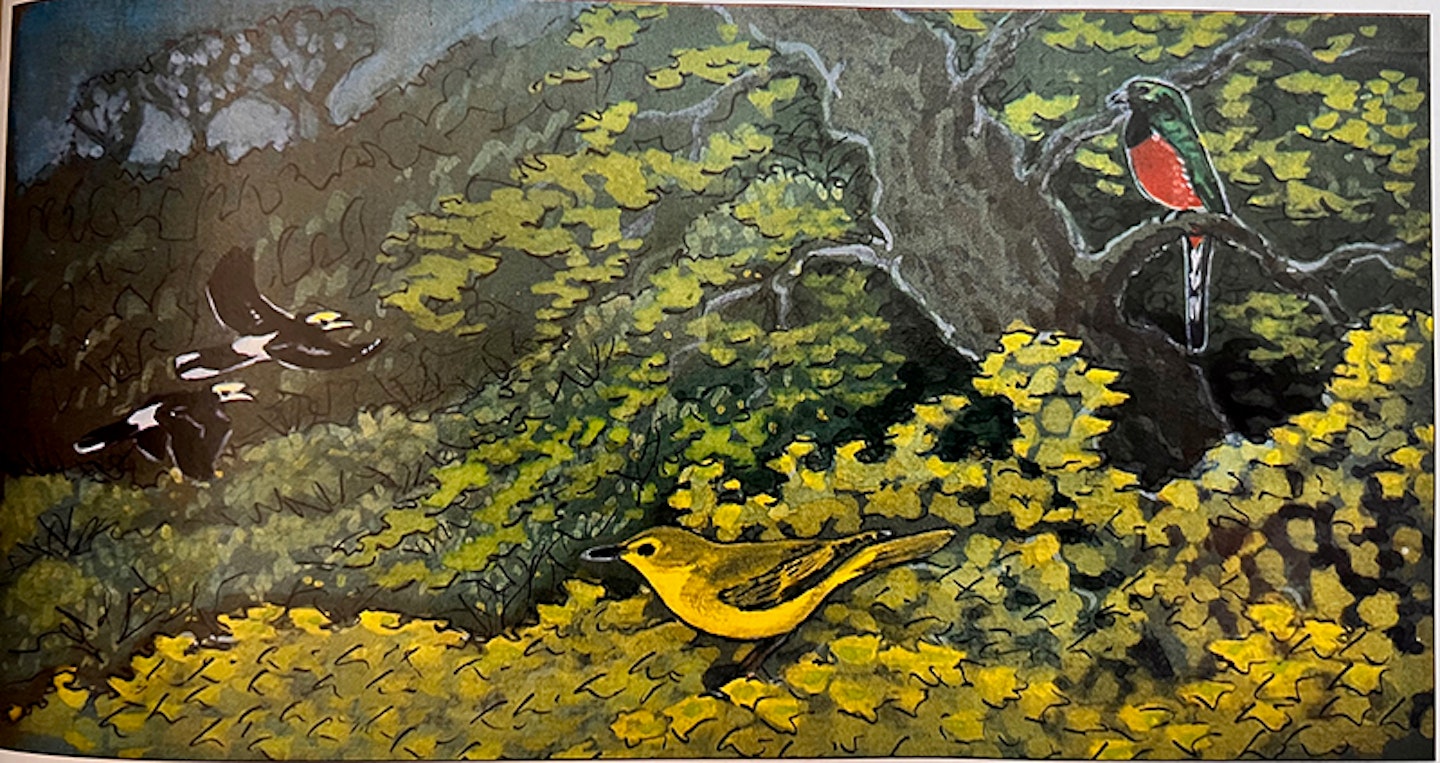
Several councils of pursuit were called and gradually a solution to our problems was found. This was to cease bashing our way directly and noisily through bush and trees. Instead, we began to use big game “tunnels” – elephant’s are best, if you do not trip over their droppings – and whatever natural contours or breaks existed. This made our searches much quieter. Lastly, we learnt to lie in wait wherever a field of view presented itself.
This strategy did not increase our military score much, but it improved my close horizon birdwatching, enormously. At last, I truly saw hornbills, turacos and – only once but unforgettably – the fabled Narina’s Trogon.
The preçis of my Kenyan forest fieldcraft lessons was: avoid cutting cover (far too tiring and noisy) walk quietly and slowly (inevitably), find observation points with as long, wide and level a field of view as possible (avoiding particularly the tiring need to look up), adopt comfortable watch positions (no fidgetting), wait (patiently) and see.
I put this stratagem in my mental rucksack.
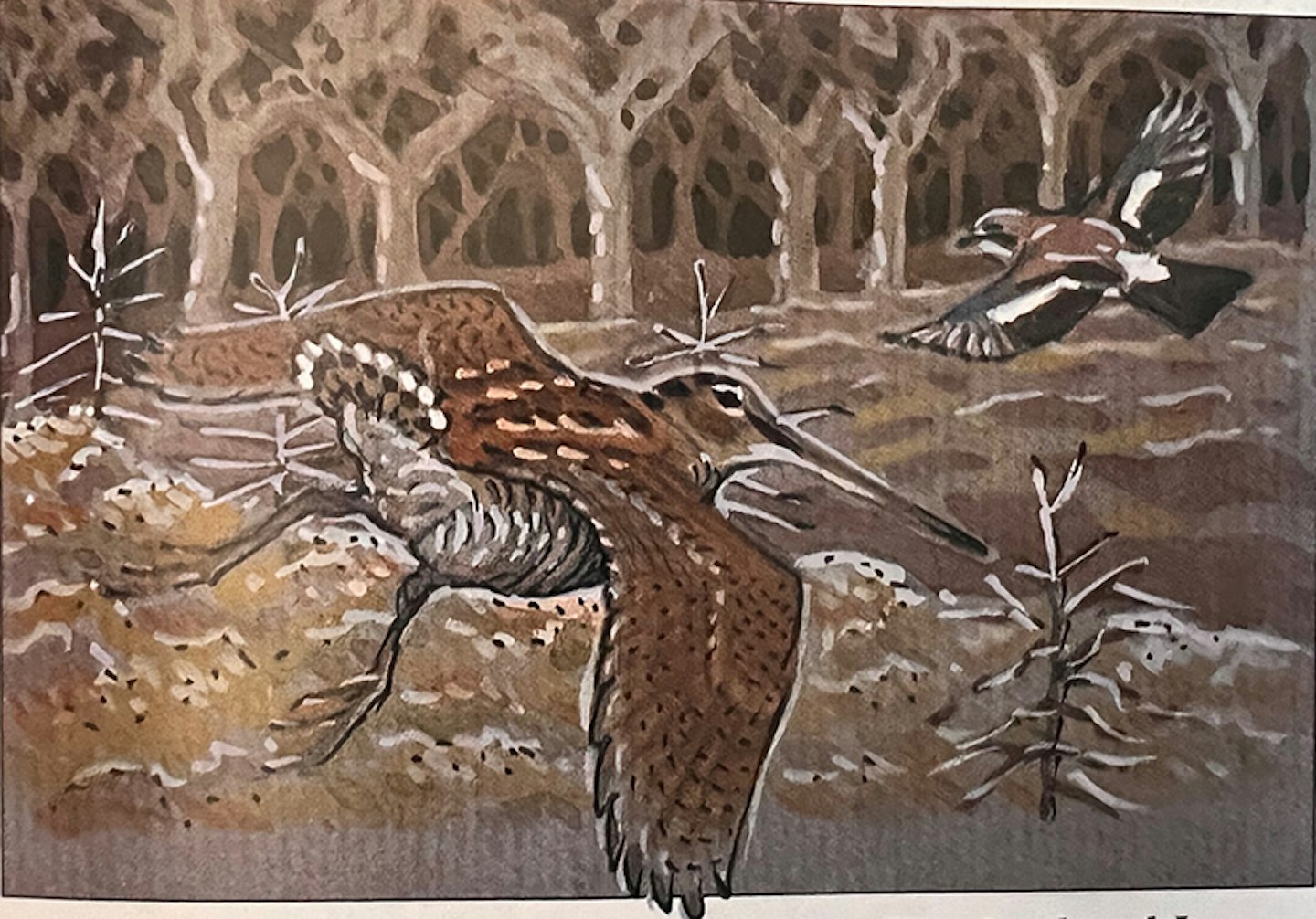
In 1968, I returned to Africa and faced again the task of seeing birds in tall forest and thick secondary growth. I “unpacked” my Kenyan lessons but sadly they did not cope fully with the additional problem of most southern Nigerian forests.
Being flat, they didn’t offer the slopes that eventually provided fields of view in Kenya. Happily, the lack of militant guerillas did allow fuller concentration on bird-finding techniques.
The missing tricks were:
discover the best food sources (and concentrate on them) and be even more patient in determining the track of calling birds (for they usually appeared on the edge of their cover, eventually). The sunlit edges of upper canopies, the massed flowers of some trees and – my favourite – the ripe fruit of the cashew are three examples of foliage sectors that allowed me to sample more easily the contingents of forest birds.

Coming home in 1971, we first lived within sight of Epping Forest. Thus, on my second return from Africa, my tendency to dive deeply into woodland persisted. Nowadays, I spend about a third of my study patch hours in thickets and woods. Birdwatching there is always intriguing, offering a very different challenge in fieldcraft and equally distinctive meetings with birds.
The woods and thickets of Britain rarely reach jungle density, but most of my African lessons have been applicable to finding birds within them. Some other stratagems have evolved over the last two decades and these I now offer to you.
Most of my woodland watching has been done in the predominantly deciduous tracts of Epping Forest and the mixed coniferous and deciduous plantations of East Riding and East Staffordshire farmland. All of these have been interrupted by roads, foresters’ and gamekeepers’ access ways, cleared tracks under pylons and traditional paths; again, all have had natural glades or artificial clearings within them.
It makes sense to plan woodland exploration with some care, using existing routes for entry and internal search whenever possible. These can be read from any large-scale map and oriented to accommodate variations in light and wind source.
Yes, even within woods, it is best to have your targets upwind and as well lit as possible.
The use of existing breaks in the trees also allows you far quicker and quieter intersection of their avian inhabitants. Birds are never uniformly dispersed in woodland cover and on any visit, it makes sense to discover quickly which trees or ground cover are providing the best shelter or food sources.
Usually, I enter a wood at a fair trot, stopping only when I hear the sounds of birds. At all seasons in dense cover, your ears become your primary bird detectors. Indeed during the full song chorus of spring and early summer, you may not need to use your eyes at all, but if, as in my own case, your aural memory is far poorer than your visual retention, there will always be some notes and songs that lead you into a stalk after its utterer.
Opinions differ on the best stalking technique. On my 1950 trip to Siberia, I was amazed to see some of my companions charge straight towards unknown songsters. As I suffer from right ear dominance, it can take me long risky minutes to fix sound sources. Necessarily, I have to vary my listening angle and look for movement.
Observing me in this routine above Lake Baikal, the amazing 6,000 lifer man Stuart Storey commented : “You don’t half hang back from your birds, Ian.” I had to reply: “Well, that’s because I don’t always know where they are!”
One modern aid helps dramatically to cut down voice confusions and that is the tape cassette. If you become serious about woodland birdwatching, your library really should contain some of those that the RSPB and others offer.
Mind you, they are not encyclopaedic. How I wish that there was one that spelt out the calls of adult and juvenile birds during the latter’s fledging period. After 48 years, I still do not know all of these.
With practice – and close study of detailed habitat references such as those in the old Handbook or Birds of the Western Palearctic – you can learn to locate some more specialised birds by spotting first their “host” tree or plant.
In England, I try harder for Wood Warbler in Beech and Oak than in other trees; in Scotland, I fancy the same bird in Birch and Ash. If I am after Hawfinch, I look first for high, thick canopies above or near Cherry, Yew and Hornbeam to which the elusive “parrot-finch” makes feeding sorties.
In autumn and winter, many woodland birds form flocks and rove wildly in search of food. So, it is important to develop a sense for such bands. The call of a Wren, a Robin or a hardy resident cock Blackbird – all likely to be solitary – can usually be ignored, but a chorus of tit calls or the notes of Nuthatch or Treecreeper cannot be, for such sounds will probably stem from a group of 20 or 30 birds. With the commoner ones may appear such treats as Lesser Spotted Woodpecker, Siskin, Redpoll or even ghostly Northern Bullfinches[listen for ‘’toy trumpet calls]..
In winter, when the birds are really intent on feeding, they will often ignore your presence. Standing in their path may cause you to be literally surrounded by Long-tailed Tits and Goldcrests searching twigs for mites, only feet, even inches from your face. Magic!
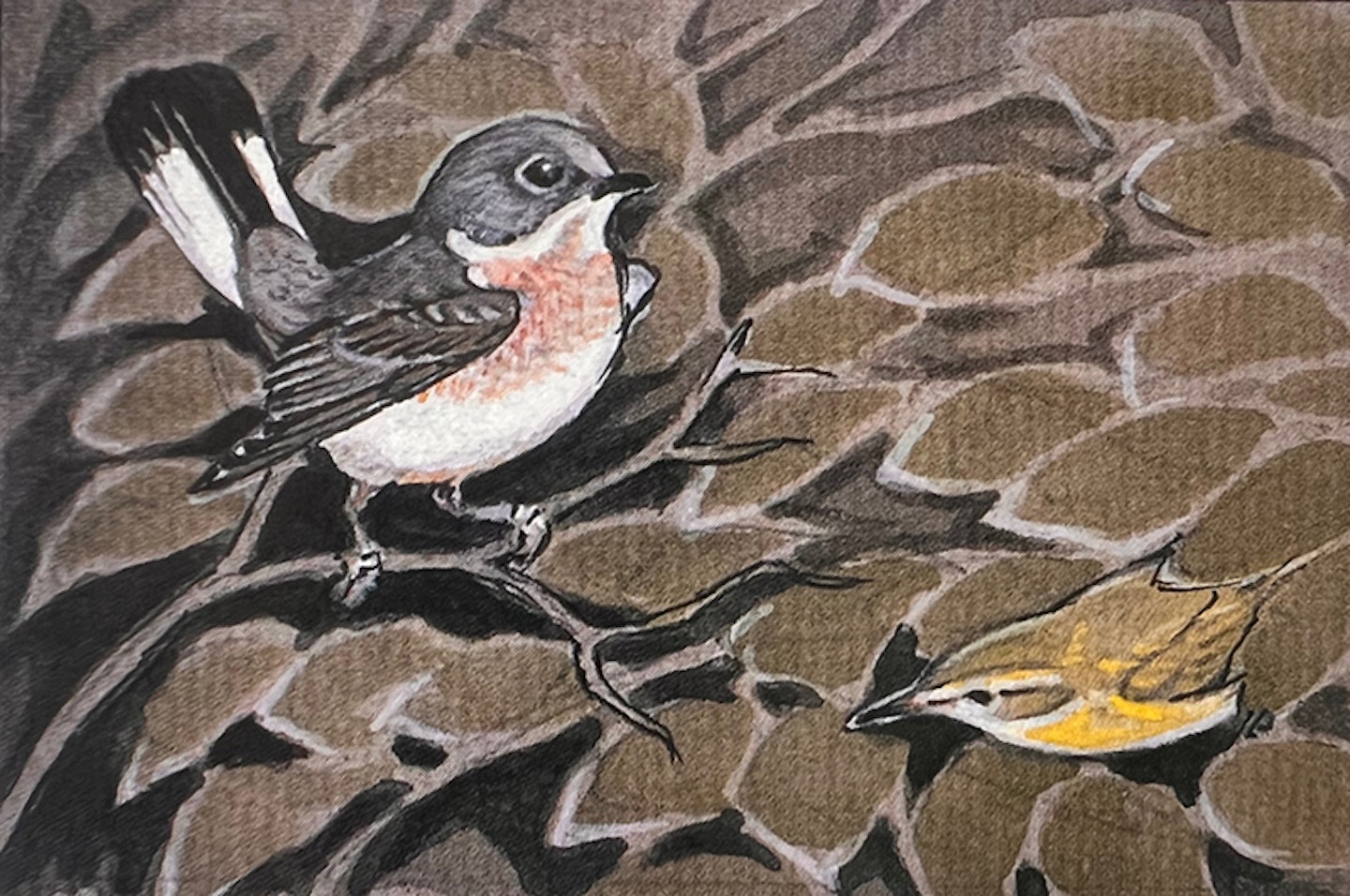
To find raptor in dense cover is difficult. They are likely to slip away before you. So, it is better to survey your wood at a distance and, particularly, to see whether any come up to display in the warmer airs of spring. This form of observation can take hours but you may remember from my tale of New Forest Honey Buzzards that the results can be wonderful. It is a sure way of finding Accipiters and buzzards.
Let me switch now to considering migrant-searching in dense cover. To the droves of observers now combing coastal woods and gullies, the requirement of cautious fieldcraft – for the sake of the tired birds – is a topical issue.
Furthermore, the circumstances of major falls often mean that you will have to contend with the high wind speeds and low light values that bad weather brings. It may make sense in early morning searches to reverse your light angle and look first for birds as dark moving silhouettes. As these are often set among flickering leaves or against a waving tracery of branches and twigs, it is no easy task. With practice, however, you should be able to detect the extra weight and momentum in a flitting bird’s image.
To spot the tell-tale silhouettes in wooded gullies or along tall hedges, it may be necessary also to follow the lowest level of search route. This may mean looking up. which is tiring and awkward to sustain, but it is often the quickest way to find the precious bounty during short October days!
Then comes your personal debate on how to manoeuvre yourself into a better watching and identifying position. Remember always that a clear view – even at some distance – is of more use than a momentary glimpse at point-blank range. (Yes, I agree that this stratagem won’t work for ground-skulking rarities like Dusky Warbler, but then it ought to be loudly calling ‘chek’ and wing-flicking like mad, even in a glimpse).
The magic of a winter tit flock – Long-taileds playing ‘follow my leader’, plus Great, Blue and Coal Tits with Goldcrest.
The other trick with migrants is to ‘wait and see’ in the lees of dense cover. With insectivores, your patience should be quickly rewarded, but with fruit-and-seed-eaters content to feed inside, you may still have to find a way through.
Alternatively, you could try another wait at the nearest water source. Birds with dry diets drink quite frequently. I learnt that fact from the late Dick Bagnall-Oakley of early Norfolk bird film fame. Watching me pound breathless along the path from Wells in search of the 1966 Two-barred Crossbill, he instructed; “Don’t thrash about on the trees, lad. Sit by the crossbill’s drinking pool. It comes there with Commons every three hours.”
Being already 33 years of age, I did not much enjoy the “lad” epithet, but as a Senior Master of Gresham’s (and someone who had seen me as a babe, the rather autocratic Dick saw my generation as a collection of eternal boys. About the rarer crossbill, he was absolutely right.
Using his advice, several now “veteran lads” had the superbly pink, black and white-barred cock bird on the deck at 20 yards for five minutes. It was an object lesson in not employing unnecessary field craft!
My comments on working close horizons should not be taken as the last words on the subject. Please remember that I am essentially a “hunter/counter” and not a behaviourist. For further clues on how to get so close to woodland species that their territories and pairings are discernible, you must follow the examples of the Oxford ornithologists of the 1950s and 1960s, particularly in their work on titmice. Letters to the Edward Gray Institute of Field Ornithology get helpful answers.
P.S. Please remember, too, that many land owners manage their woods and coverts for both game and timber profits. Their keepers do not take kindly to strangers. So, always clear your rights of access first.
